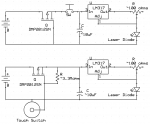Hi folks! Been watching this forum for a few months, but it's my first post!
Anyway, I'm working on a crazy Blu-Ray pointer circuit that I'll describe more later, but I wanted to share an idea with you DIYer's who are still using silicon diodes to protect from putting the batteries in backwards. First some rants:
(1) Why are you using silicon??? It's got a lousy 0.7v drop, and we all know volts are valuable to a laser diode! AT LEAST use a Schottky, like the cheap-o BAT54, which gives you a paltry 0.25v drop for a dime.
(2) Some people put the diodes in shunt with a drop resistor between the battery and diode - but then you lose voltage across the resistor!!!
Don't use diodes!!
I propose the use of a p-channel MOSFET (for those with can-positive diodes, you can use the much more common n-ch MOSFETs). I've just simlated one below. I chose the DMP2012SN from Diodes, Inc. because it has BOTH a gate protection double-zener and a V_DS protection Schottly built in, so you don't have to worry about static frying the MOSFET!! And it's a tiny SOT-23 package.
To explain the simulation, I simulated the battery as a simple voltage ramp from -5 to +5v to show how it behaves even if the battery is backwards. This voltage ramp feeds the drain-pin of the p-MOSFET and the gate is grounded. Vin<0 corresponds to when the battery is backwards (the green and cyan lines in plot overlap for Vin<0 in the plot), and the output voltage, Vout (red line) is a nice 0v! Note also the blue line is the current in the load resistor, chosen to be a hefty 30 ohms. For Vin<0, there is no current flowing to your precious laser pointer.
The input voltage crosses 0v around 0.5s and still no output current. That's because the gate voltage needs to be below the source voltage to turn on the p-FET. Right around Vin=1v, the the turn-on threshold is reached and we start getting current. Since this p-FET has an on-resistance (RDSon) of only 0.4 ohm, there is only about a 45mV (0.045v!!) drop from the battery to the load. That's 10x better than Schottky and 20x better than silicon!! It might cost you $1, but in my opinion, it's worth it. BTW, you CAN find p-MOSFETs with RDSon of as low as 0.04 ohms or even less, I just wasn't patient enough to find any that also had both gate and D-S protection.
[The image is supposedly attached - I didn't figure out how to embed it yet]
Good luck and keep lasing!
Anyway, I'm working on a crazy Blu-Ray pointer circuit that I'll describe more later, but I wanted to share an idea with you DIYer's who are still using silicon diodes to protect from putting the batteries in backwards. First some rants:
(1) Why are you using silicon??? It's got a lousy 0.7v drop, and we all know volts are valuable to a laser diode! AT LEAST use a Schottky, like the cheap-o BAT54, which gives you a paltry 0.25v drop for a dime.
(2) Some people put the diodes in shunt with a drop resistor between the battery and diode - but then you lose voltage across the resistor!!!
Don't use diodes!!
I propose the use of a p-channel MOSFET (for those with can-positive diodes, you can use the much more common n-ch MOSFETs). I've just simlated one below. I chose the DMP2012SN from Diodes, Inc. because it has BOTH a gate protection double-zener and a V_DS protection Schottly built in, so you don't have to worry about static frying the MOSFET!! And it's a tiny SOT-23 package.
To explain the simulation, I simulated the battery as a simple voltage ramp from -5 to +5v to show how it behaves even if the battery is backwards. This voltage ramp feeds the drain-pin of the p-MOSFET and the gate is grounded. Vin<0 corresponds to when the battery is backwards (the green and cyan lines in plot overlap for Vin<0 in the plot), and the output voltage, Vout (red line) is a nice 0v! Note also the blue line is the current in the load resistor, chosen to be a hefty 30 ohms. For Vin<0, there is no current flowing to your precious laser pointer.
The input voltage crosses 0v around 0.5s and still no output current. That's because the gate voltage needs to be below the source voltage to turn on the p-FET. Right around Vin=1v, the the turn-on threshold is reached and we start getting current. Since this p-FET has an on-resistance (RDSon) of only 0.4 ohm, there is only about a 45mV (0.045v!!) drop from the battery to the load. That's 10x better than Schottky and 20x better than silicon!! It might cost you $1, but in my opinion, it's worth it. BTW, you CAN find p-MOSFETs with RDSon of as low as 0.04 ohms or even less, I just wasn't patient enough to find any that also had both gate and D-S protection.
[The image is supposedly attached - I didn't figure out how to embed it yet]
Good luck and keep lasing!







